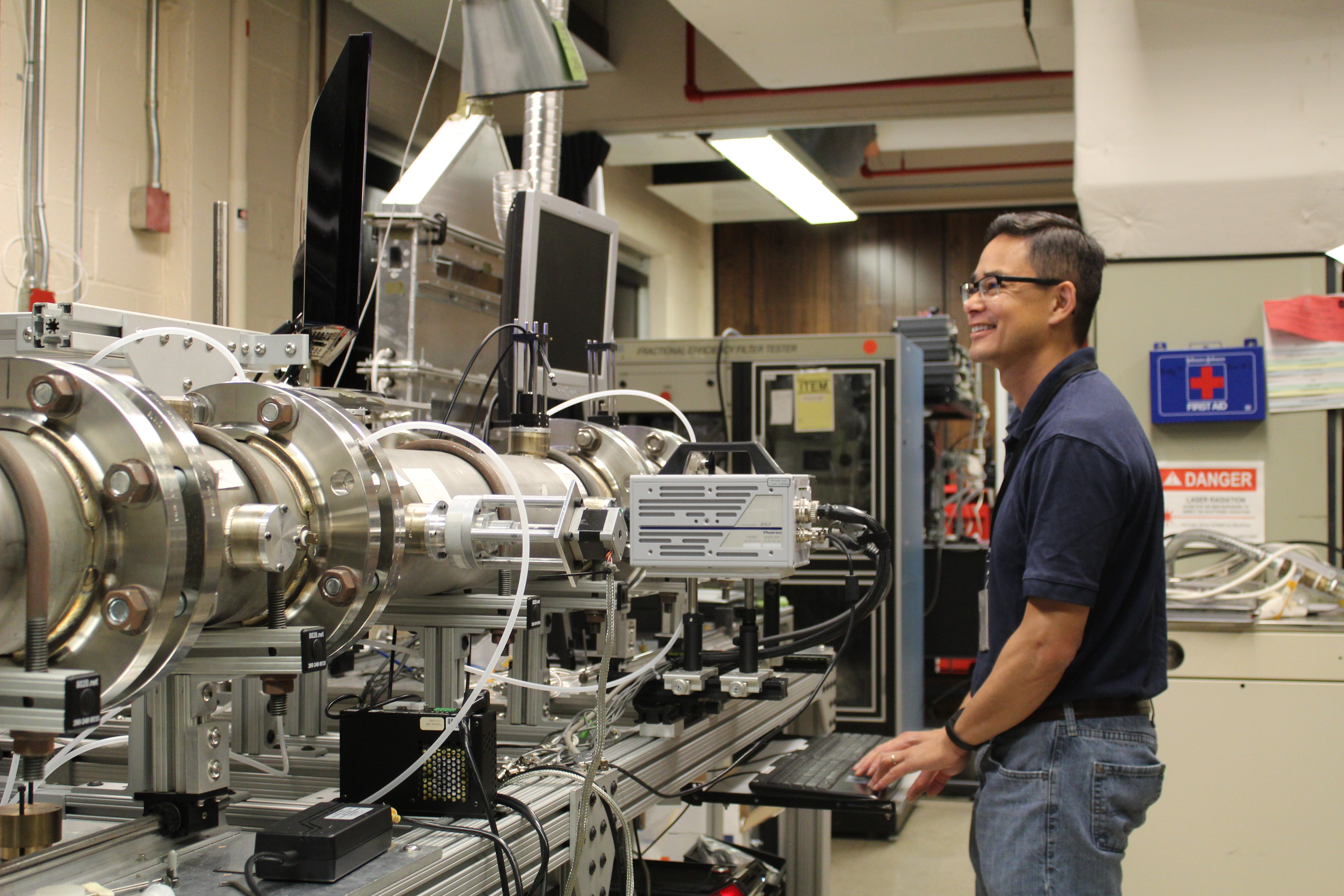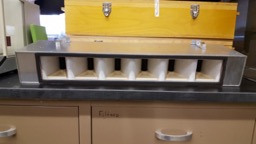
Inventor Juan Agui in his lab at NASA's Glenn Research Center.

Agui's multi-stage filtration system
I am an aerospace engineer in the Thermal Systems and Transport Processes Branch at NASA Glenn Research Center located in Cleveland, Ohio. The main focus of my work is developing advanced air and gas filter systems for future crewed vehicles and robotic deep space missions. At NASA GRC, filter systems are being developed under the AES Life Support Systems project (previously under the Exploration Life Support and Life Support and Habitations project) and under the AES In-Situ Resource Utilization (ISRU) project.
The ISRU project which is developing atmospheric processing systems for oxygen and propellant generation on the Martian Surface will require effective filters to remove atmospheric Martian dust at the inlet of the process reactor. My job is to design, prototype and test these filter systems with an emphasis on extending filter life, adding regenerability, minimizing equivalent system mass, and reducing maintenance crew time.
I received my Bachelor’s degree in Mechanical Engineering at the New York Institute of Technology and my masters in Mechanical Engineering at the College of New York. I went on to get my Ph.D. at the City University of New York with an emphasis on high-speed turbulent flows.
In 2011, I received an Exceptional Achievement Medal for exceptional scientific and technical contributions to dust filtration research for Exploration Life Support. In 2004, I received the Silver Snoopy award for my role as a Project Scientist for the InSPACE science payload on the ISS. In 2007, I was selected as a Luminary Honoree at the HENAAC conference.
What does this invention do?
The unique multi-stage filtration system collects a wide range of particle sizes with minimal filter changes. This breakthrough capability keeps high-efficiency media and devices from becoming overloaded with larger particles. Glenn's system (known as the Scroll Filter System) uses an impactor filter to capture larger particle matter through inertial separation and impaction methods on collection surfaces. After becoming heavily loaded, this filter can be cleaned automatically through a unique feed system, thereby reducing maintenance costs.
In this way, the device provides a pre-filter stage that protects the more critical stages of the filter system, thereby extending the life of high-efficiency particulate arresting (HEPA) filter systems that are designed to capture fine and ultrafine particles.
In an effort to reduce maintenance even further, the fine-particle filter media is provided in a scroll mechanism that is advanced to successive clean sections as needed. Highly sensitive filtration systems can be challenging to maintain and protect, so Glenn's system, which provides time and power savings offers great potential for commercial development.
What problem does this technology solve?
Air filter systems require constant and routine maintenance due to the buildup of dust or particulate matter on the filter components and media. Often media filters are replaced once they have reached their service, or they may require a vigorous cleaning process to regenerate them. On board the ISS, filter systems are serviced almost on a weekly basis to remove large debris matter from the cabin pre-filters.
Future deep space crewed missions will be of extended duration with limited crew time to maintain the filters, and with limited payload capability to carry replacement units. Current state of the art filters will be limited in their performance during these missions. Therefore, there is critical need to develop more capable filters that will perform reliably during the length of the mission.
Current filter developments at the GRC are aimed at overcoming the limitations of present day filters for deep space missions.
Who else might benefit from this technology? What other applications do you envision?
Filter manufacturers and the HVAC (Heating, Ventilation, and Air Conditioning) community are potential users of this technology. Filtration is especially important in the pharmaceucial industry.
Particle generators are a key part of maintaining FDA strict filter standards in pharmaceutical manufacturing facilities. Even a small amount of airborne contamination while manufacturing drugs could affect the safety and efficacy of the drug. Pharmaceutical manufacturing and packaging rooms have complete filtration rooms designed with filters in the ceilings to provide critical filtration to eliminate potential viruses and bacteria.
What are the commercialization possibilities?
Potential commercialization of the filter system is anticipated in residential or commercial HVAC applications, as well as specialty applications for closed/sealed or remote environments where long maintenance cycles are required. These may include submarine cabins or in scientific or operational bases in remotes parts of the Earth (e.g. Antarctica).
Do you have any future plans to continue development of this technology?
The AES LSS project is currently funding the development of the current filter system for a technological demonstration (Tech Demo) aboard the ISS. The ISRU project is also interested in developing a small version of the Scroll Filter System for use in a Martian atmospheric acquisition reactor system that can convert the Martian mostly carbon dioxide environment into oxygen for storage.
Is there anything else you want us to know about your innovation?
The filter system is modular and highly customizable. The different stages of the filter can be interchanged or reconfigured depending on application or performance requirements. By adjusting design parameters and filter media grade the overall performance of the filter can be customized to meet user specifications.
Whom should I contact if I want to know more about this technology?
Companies interested in licensing any of the filtration technologies are encouraged to email us to discuss licensing needs and objectives. We will connect you with the appropriate Technology Manager that will guide you through the licensing process.
Learn more about this technology here.
Publications
NASA Lunar Dust Filtration and Separations Workshop Report
Development of a Multi -Stage Filter System for Cabin Ventilation Systems on the ISS and Future Deep Space Missions
Particulate Matter Filtration Design Considerations for Crewed Spacecraft Life Support Systems



